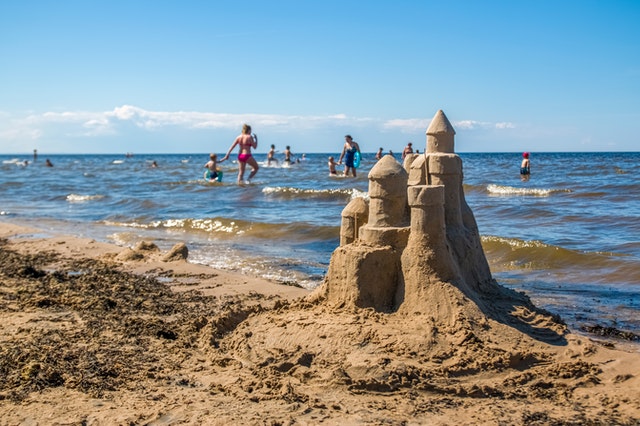
by pankaj | Mar 12, 2022 | Vacations & Leisure
It takes extra effort to dine out when it’s raining. However, it’s an excuse to get dressed up, it’s cozy and romantic, and you’ll get better table service.
When it’s raining, the last thing we feel like doing is going outside to clear the letterbox, let alone venturing out for dinner. However, certain advantages exist for dining out on rainy evenings that you don’t get on clear days. It’s the perfect excuse for getting out of your pajamas, there’s nothing quite as romantic as a candlelit dinner when the windows are all steamed up, and you won’t have to fight quite as hard for a table or a car park.
A Good Excuse for Getting Dressed Up
Dining out when it’s raining is a good reason to get out of your pajamas. I know it’s enticing to stay indoors dressed in nothing as comfortable as pajamas or trackies and an oversized sweater. Yet, it can be just as rewarding to get dressed up. If you are like me and have more clothes than you need, it’s an excellent excuse to wear some of those items that have been relegated to the back of the wardrobe.
During the winter, clothes can get mold spots if they are not aired out properly, so dining out during the rainier months can ensure that the clothes in your wardrobe get a good airing out. And don’t be discouraged by wearing an oversized rain jacket over the top of your clothes, as most restaurants have room to store your wet weather gear.
When it rains, candlelit dinners are more romantic.
Candlelit meals are fantastic. The candlelight and its warmth are even more beautiful when it’s pouring. When you dine out when it’s raining, the extra effort feels more rewarding and makes one more appreciative of the dining experience.
When it’s raining out, you are more likely to make the most of your time out because the possibility of getting wet is a deterrent. In addition, a more extended dining experience can produce a more meaningful and memorable experience. Date nights are also nights that shouldn’t be missed, raining or not. The extra effort is unlikely to go unnoticed or unappreciated.
It’s Easier to get Good Restaurant Service When it’s Raining.
Rain deters many diners, so you are more likely to get a table and a good carpark on a rainy evening. Not only that, but service may improve with fewer diners.
During my last rainy night date, the waiting staff was able to anticipate our needs better, they came back more often to check that we were enjoying our meals, and we didn’t feel so rushed. You’ll also appreciate the greater chance of finding a carpark right outside the restaurant when it’s raining.
Dining Out on Rainy Nights
It takes extra effort to dine out when it’s raining. However, it makes the dining experience far more memorable.
Remember:
Dining out when it’s raining is a good reason to get out of your pajamas. There’s nothing quite as romantic as a candlelit dinner when the windows are steamed up. Dining out during the rainier months can ensure that the clothes in your wardrobe get a good airing out. It takes extra effort to dine out when it’s raining, but it makes the dining experience far more memorable. Date nights are also nights that shouldn’t be missed, rain or not. And don’t be discouraged by wearing an oversized rain jacket – most restaurants have room to store your wet weather gear.

by pankaj | Mar 12, 2022 | Vacations & Leisure
Fun and Cheap Activities to Do When BoredIf you think you need help because you’re bored, then look no further – here are a few cheap, fun activities to fight boredom and keep you busy.
With people’s busy schedules in today’s society, boredom is no longer the problem that it used to be. However, even with technology and new locales to visit, there are still those days when you are bored and wondering what to do. Having fun shouldn’t be expensive. Relaxation doesn’t have to be costly. Here are a few fun, cheap activities for you to do when you feel bored on those rare occasions — you may be surprised at how fast time flies.
Explore the World around You
You can find something fun to do without spending a dime just by going outside. Take a walk in those nearby woods, go for a stroll on the beach, or hike that uninvestigated hill. Seeing the beauty and diversity of nature around you is a great way to fight foredoom and learn something simultaneously. Make things even more fun by taking note of any exciting animals or plants you see along the way.
Stargaze for a While
Though this may be more difficult for city dwellers, stargazing is a beautiful (and free) way to have some fun when bored. On a fantastic night, pitch out a couple of blankets in your backyard or on a spare spot of grass. You can grab some friends or go yourself — it offers a new perspective. Try pointing out any constellations you see, or even a shooting star!
Cook Something New
Here is yet another fun and cheap activity for you to do when the weather outside isn’t favorable to the above two ideas. Dust off your grandmother’s old cookbook and fight the boredom by whipping up dinner or dessert! You may pass the time and improve your culinary abilities by cooking. Follow the recipes with family and have fun as you bake, season, and spice your food to perfection. Once you’re munching on some delicious snacks that you proudly made yourself, you probably won’t be saying you’re bored any longer.
Participating in these enjoyable but low-cost activities will no longer be boring, and you might have just found a new activity to do more often. But, again, in today’s busy world with deadlines, business meetings, and hectic schedules, sometimes such fun activities like those listed above are just what you need to relax and release the stress that’s been building up inside you. So go out and don’t let boredom bore you another day — take advantage of some of these cheap and fun things to do instead.
Conclusion:
With technology and new locales to visit, there are still those days when you are bored and wondering what to do. Having fun shouldn’t be expensive. Here are a few cheap activities for you to do when you feel bored on those rare occasions — you may be surprised at how fast time flies. Dust off your grandmother’s old cookbook and fight the boredom by whipping up dinner or dessert.

by pankaj | Mar 12, 2022 | Travel Tips
Travel insurance is a must-have nowadays. The insurance will cover canceled trips and flights and medical help if you are injured.
Why not ensure your trips like your house, vehicle, and health? Unfortunately, there are stories of those on vacation who find themselves without a holiday because the flights were canceled or the hotel canceled your reservation, or worse, lost your reservation. Every day, luggage gets misplaced, and it is increasingly becoming the norm.
Things happen while on vacation, and there is nothing anyone can do about that, but there are ways to make the adverse events more palpable. Even the worst vacation stories will probably not make you cancel your vacation. Travelers have been spared the drastic effects of a vacation snafu, allowing them to return home and regale their family and friends with tales of a break interrupted.
Travel insurance will save the day by ensuring the traveler for insurable events before or during a vacation. For example, you are covered if your holiday is canceled or interrupted. Your baggage is protected if lost or stolen. If you incur medical expenses, including hospitalization, you are covered, but only if insured.
Choosing the Right Travel Insurance for You
No one travel insurance policy will cover every little detail of the vacation, but it will cover loss due to trip cancellation either before or during the trip. It will cover the loss or damage of personal property or loss or damage of rental vehicles, cancellation of hotels and flights, and other travel alternatives. Travel insurance will also cover medical care and hospitalization, and evacuation in case of severe illness or injury. Make sure you check out the travel insurance plans carefully and thoroughly.
Before choosing your travel insurance package, list where you are going and what you will do when you get there. For example, you might not need anything in the heavy-handed hospitalization area if you are a typical sight-seer. On the other hand, if you are skiing or skydiving, your travel insurance includes hospitalization and emergency rooms. You may find out that country status might void your health insurance coverage, and having access to medical care while on vacation is essential.
If you are visiting an area of the world where strife might flare up, and it will be in your best interest to evacuate, you will be lucky to have travel insurance to help you do that. Otherwise, you may hurry to take refuge in the local embassy, canceling all of your enjoyable plans.
The Cost of Travel Insurance
The cost of travel insurance varies, the person’s age to be insured, the length of stay, the destination, and any preexisting medical conditions you may have. The more that is covered, the more costly the policy will be.
A comprehensive plan is usually available, and one most travelers seem to take. It covers the most unexpected events that could ever take place. You will have adequate health coverage and a variety of related travel coverage.
A medical plan covers health-related incidents such as accidents and illness. It is a favorite of those who do a lot of hiking or cross country skiing or related physical activity.
Domestic coverage is suitable for those who are not traveling beyond the country’s borders.

by pankaj | Mar 12, 2022 | Travel Tips
Travel insurance is advised before a vacation. The chance of the traveler experiencing difficulties is more significant than you think.
Acquire travel insurance straight from a provider. Additionally, some premium credit cards provide travel insurance that may be appropriate for your situation. Buy in person, via phone, or online. If you often travel, you may have a standing travel insurance package set up with your travel insurance specialist, or you may buy a package that covers all trips during the year or a specified time frame.
If you opt to buy travel insurance through a premium credit card, check the terms and conditions carefully for any limitations placed on travel. You may also be required to pay for your trip with that credit card to take advantage of the travel insurance. However, some premium credit card travel insurance programs are free. In contrast, others may charge a minimal fee for the coverage, which could be less costly than an independent travel insurance package.
Make sure the coverage offered fits your trip entirely and will cover any elements undertaken during the trip. For example, if you are going on a skiing or skydiving vacation, the coverage should include hospitalization and death benefits.
Checklist for Travel Insurance
Ensuring your health is critical while traveling. If you are abroad, your health insurance may not cover any health-related issues, even if it is persistent. If your health care covers health-related matters while on vacation, it may only cover certain aspects of a certain level of expense. The best travel plan will include unlimited medical coverage no matter where you travel.
Before choosing travel insurance, understand what you are covered for and what coverage does not include. The details of the plan are always available in a disclosure brochure. The information can be requested from the travel agent insurance provider or found online. Read the material attentively and comprehend the strategy.
The travel insurance plan must cover the events you will participate in or encounter while away. For example, if you embark on a skiing or bungee jumping vacation, make sure plenty of hospitalization is included, especially evacuation and transport back home for medical care or with medical attendants if necessary.
Check the travel insurance plan if there is coverage for weather or environmental-related events and the necessity to leave that country immediately. For example, if you are visiting a country where strife and unrest break out, is there a plan and coverage to allow you to leave the country and seek a haven before continuing home?
In addition to health care coverage, you want your travel insurance plan to cover the cost of a canceled trip in whole or in part. The point of insurance is to prevent the trip from costing money and not being able to take advantage of it. Other things to make sure are covered canceled flights, lost or damaged luggage, alternate transportation, and housing. Travel insurance usually does not cover travel expenses incurred if you cancel or revise the travel plans for no apparent reason.
Other Travel Insurance Coverage
Some travel insurance plans cover car rentals in case of an accident, mechanical failure, or personal property theft from the vehicle. The coverage may also include a car you hire consisting of a driver and a rental you drive yourself. If you utilize a car for many of your trips, be sure the vehicle is covered somewhere in your travel plans.

by pankaj | Mar 12, 2022 | Vacations & Leisure
Step-by-step instructions to build an impressive sandcastle with your family and friends on the beach.
Summertime is great for fun activities with friends and family. Of course, there are many activities to pursue with those you love, but building a sandcastle can be a favorite at the beach. Here are four simple stages to building a great sandcastle, plus some tricks.
Step 1: Gather Materials for your Sandcastle
The Obvious: As with every sandcastle, you will need tons of sand and water. The sand is the medium for sculpting, which will not cooperate without water to smooth it out and hold it together. In addition to this, you will need shovels and buckets to shape the sand the way you wish and to make it easier to lift and move. Make sure you bring a couple of different sizes and shapes for stylistic purposes.
The Not-So-Obvious: After the primary building of the sandcastle is done, you can use almost anything to decorate the outside of the castle. Things lying on the beach make incredible decorations, such as feathers, shells, coral, and driftwood. Other than these, you can bring different tools to add texture to the castle later. Everyday things such as kitchen tools and paintbrushes make fantastic tools.
Step 2: Pile on the Sand
Before you even pick up a bucket or shovel, you have to choose a place for your sandcastle along the beach. Keep an eye on the tide. The water destroying a half-finished sandcastle is the worst.
If you are making an intricate sandcastle with an idea for more of a sculpture instead of an architectural project, it may be easier to start with one giant pile of sand. Pour water onto the pile of sand until it is packed down and easy to work with. Don’t worry about pouring too much water because any excess will drip through. The wetness of the sand makes it sturdier and gives it smoothers lines. You may now continue carving your sandcastle as you choose.
However, there is the possibility that you are not a sculptor and that you want to build a regular old sandcastle on the beach. In this case, start with a base of sand that you want to be the center. The buckets that you have brought are perfect for making this base. When you put water into a bucket, you want it medium wet. It can’t be too dry that it doesn’t hold shape, but not too wet that the sand doesn’t budge from the bucket when you turn it over. Buckets can build impressive constructions like the castle’s towers and walls. There are many buckets out on the market with ridges and designs for decoration. Makes sure these are entirely packed with sand before you flip your bucket or they will appear cracked and not all there.
Step 3: The Moat
It is an optional step. Not every sandcastle needs a moat, but they often look much more relaxed and potent with some water around the edges. To create a canal, dig a trench around the base of your sandcastle. It can be around, square, or intricate pattern. The shape doesn’t matter. Secondly, you will want to pour water around the edges of the trench to smooth out the walls and base. It will appear neater and completed. Finally, make sure there is no loose sand around the edges that could fall inside your trench.
If you want to fill your moat with water, you may want to add plastic bags to your list of sandcastle materials. If you choose to do so, you will dig your trench first, then line the bottoms and sides with trash bags. It prevents water from penetrating the sand below. After doing this, completely cover the bags with about an inch or two of sand. The sand will flatten and spread when you pour water onto it, so be sure to put enough sand so you don’t see the bags underneath. After you have your sand, slowly pour water to fill up your moat.
Step 4: Decorating Your Sandcastle
Finally, the most accessible and amusing is no set path to follow. Have fun and make your castle however you want. Place all the decorations you have gathered on your sandcastle to give it something a little extra. Don’t forget about texture if you don’t think you will like that look. Forks and knives from the kitchen can make astonishing patterns along the edge of your castle. Finally, don’t forget about strange things such as a paintbrush or even a piece of coral. These things can make astonishing patterns in multiple places along the walls of a castle.
Finally, sit back and enjoy the masterpiece you have created with the people you love, or simply as a relaxing exercise by yourself. If it’s something you love, don’t forget to take pictures before the sea washed it away.

by pankaj | Mar 12, 2022 | Travel Tips
Preparing for an overseas vacation takes planning. Divide your plan into tasks that need to be done months, weeks, and days before departure.
The success or failure of a much-anticipated vacation can lie in the details of the planning, that is. From deciding where to go through to finally getting on the airplane, many arrangements must be made. Make the process less arduous by dividing these arrangements into tasks to be tackled months, weeks, and days in advance of travel.
Planning for a Vacation Months in Advance
The decisions to be made as far in advance as possible are the ones that are going to cost you the most. These include airfares, hotel bookings, travel insurance, and travel visas.
Booking months in advance usually results in lower airfare. For example, in New Zealand, Earlybird deals for long haul travel generally come out three to four months in advance of peak travel periods. Once you’ve purchased your airfare, remember to submit any seating or meal requests to the airline.
Similarly, hotels prefer to have their rooms booked as far in advance. Therefore, you are likely to have more hotels and deals to choose from when booking months in advance.
While last-minute deals on airfares and accommodation are standard, their chances of being applicable and available on your specific dates are rare. Traveling with a family or just at certain times of the year, booking ahead is more likely to save you money than booking at the last minute.
As soon as you have paid for airfares and accommodation, you should also purchase your travel insurance. Travel insurance should be purchased simultaneously as your big-ticket items so that you will be covered immediately against cancellation penalties if any unforeseen circumstances arise that may delay or cancel your travel plans.
You should also investigate if travel visas are required and, at the same time, ensure that your passport is valid for travel to your particular destination. This is because travel visas and passports can take a long time to process, especially if the embassy or passport office is overseas.
Planning for a Vacation Weeks in Advance
Planning what to do when you are away and what to take should be done weeks in advance. It is so that any dentist and doctor’s appointments can be tidied away, especially if you need to renew prescriptions or get vaccinations. These are usually tasks that require a few weeks’ planning.
Booking house sitters or kennels and catteries for pets often need to be made weeks, if not months, ahead of travel. Booking car parks at the airport or booking a shuttle to take you to the airport should also be squared away weeks in advance.
Once you’ve decided where you are going on vacation, the fun part is planning what you will do when you are away. First, you can buy a brand new travel guide; although be warned, they can be costly. Alternatively, bid on used travel guides on online auction sites. If you start looking a few weeks in advance, you should be able to get a recent one at a reasonable price or take advantage of book sales. You can even download special travel guide applications to your Apple iPhone for a fraction of the cost of paper guides.
Creating a packing list a few weeks in advance will be helpful, so when you discover that you need a new bikini, you will have sufficient time to save for one or search for the ever-elusive perfect one.
A packing list will also help identify anything that needs to be purchased, such as power adaptors, a new book, earplugs, or noise-canceling headphones for the flight.
Planning for a Vacation Days in Advance
The only tasks that remain to be done in the days leading up to your vacation should not rely on supply. For example, don’t put off buying anything till the last minute. Likewise, the only things that should be done in the days leading up to your travel are charging any electronic devices you are taking, doing your laundry, and suspending paper deliveries.
Foreign currency can be purchased anytime, ideally when you think you will get the best exchange rate. I hate having money lying around the home, so I generally only buy currency in the days leading up to my travel. However, don’t leave it until the last day because it may not always be available at your chosen supplier or even at the airport if they have had a run on that particular currency.
Similarly, if you are relying on your credit card as the primary source of funds, ensure that you have transferred funds to it days in advance to allow time for all transfers to clear.
Packing takes time, so do it over days. This way, you’ll have time to reflect on the wisdom of your packing choices and alter them if need be. Also, ensure you are up to date with any laundry washing that needs to be done to have a whole wardrobe available to choose from.
If no one will be clearing your letterbox or housesitting for you, ensure that you suspend any paper deliveries to avoid making it completely obvious to opportunistic thieves that no one is home.
Have Fun!
Now it’s time to rest. Nothing is worse than stress on the way to the airport when you discover that you’ve forgotten to pack something or turn off the stove. Planning means less stress in the lead-up and more chance of enjoying your holiday because you’ll know that everything possible has been done.








